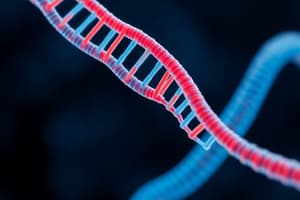Podcast
Questions and Answers
What is the primary purpose of the annealing step in PCR?
What is the primary purpose of the annealing step in PCR?
- To synthesize DNA without any template
- To allow primers to bind to complementary sequences (correct)
- To denature the DNA sample
- To amplify RNA transcripts
Which component is NOT essential for the PCR process?
Which component is NOT essential for the PCR process?
- Nucleotides
- DNA polymerase
- RNA polymerase (correct)
- Primers
What does the transcriptome represent?
What does the transcriptome represent?
- A measurement of protein levels in a tissue
- The total set of RNA transcripts in a cell at a given time (correct)
- Only the coding genes present in a cell
- The complete DNA sequence of an organism
Which of the following techniques is primarily used for analyzing the transcriptome?
Which of the following techniques is primarily used for analyzing the transcriptome?
What can changes in the transcriptome indicate?
What can changes in the transcriptome indicate?
What is the main purpose of splicing in gene expression?
What is the main purpose of splicing in gene expression?
Which statement correctly describes plasmids?
Which statement correctly describes plasmids?
What is the role of the spliceosome in splicing?
What is the role of the spliceosome in splicing?
Which component is NOT commonly found in plasmids?
Which component is NOT commonly found in plasmids?
What occurs during the denaturation phase of PCR?
What occurs during the denaturation phase of PCR?
How does alternative splicing contribute to protein diversity?
How does alternative splicing contribute to protein diversity?
Which of the following is a key feature of PCR?
Which of the following is a key feature of PCR?
Errors in splicing can lead to which of the following outcomes?
Errors in splicing can lead to which of the following outcomes?
Flashcards
Gene Expression
Gene Expression
The process of using a gene's information to make a functional protein.
Transcription
Transcription
Creating an RNA copy from a DNA gene.
Translation
Translation
Converting RNA code into a protein.
Splicing
Splicing
Signup and view all the flashcards
Plasmid
Plasmid
Signup and view all the flashcards
PCR
PCR
Signup and view all the flashcards
Intron
Intron
Signup and view all the flashcards
Exon
Exon
Signup and view all the flashcards
PCR's role
PCR's role
Signup and view all the flashcards
PCR components
PCR components
Signup and view all the flashcards
PCR steps
PCR steps
Signup and view all the flashcards
Transcriptome use
Transcriptome use
Signup and view all the flashcards
Study Notes
Molecular Basis of Gene Expression
- Gene expression is the process of using gene information to synthesize a functional gene product, typically a protein.
- Two main stages are transcription and translation.
- Transcription converts a gene's DNA sequence into a complementary RNA molecule (mRNA).
- Translation uses the mRNA sequence to create a polypeptide chain, which folds into a functional protein.
- Regulation controls gene expression timing and location, responding to cellular needs.
Splicing
- Splicing is critical for gene expression, especially in eukaryotes.
- Pre-mRNA molecules undergo splicing to remove non-coding introns.
- Exons (coding regions) are joined, forming mature mRNA.
- Alternative splicing allows one gene to create multiple protein isoforms by selectively including exons. This increases protein diversity.
- The spliceosome, a complex of snRNPs and proteins, facilitates splicing.
- Splicing errors can cause diseases.
Plasmids
- Plasmids are small, circular DNA molecules, separate from chromosomal DNA in bacteria and some other organisms.
- They replicate independently.
- Plasmids offer advantageous traits to host cells, like antibiotic resistance or unusual substance metabolism.
- Plasmids are vectors in recombinant DNA technology.
- Foreign genes can be inserted into plasmids to create recombinant DNA.
- These plasmids are introduced into host cells for expressing the foreign gene.
- Plasmids typically contain an origin of replication (ori), selectable markers (e.g., antibiotic resistance genes), and cloning sites (polylinkers) for foreign DNA.
PCR (Polymerase Chain Reaction)
- PCR is an in vitro method for amplifying specific DNA segments.
- It uses repeated cycles of denaturation, annealing, and extension.
- Denaturation separates double-stranded DNA into single strands (template DNA is exposed).
- Annealing allows primers to bind to complementary sequences, initiating replication.
- Extension enables DNA polymerase to synthesize complementary DNA strands using the template and primers.
- This cycle exponentially amplifies the target DNA.
- PCR components include DNA sample, primers, DNA polymerase, and nucleotides.
- PCR is crucial for analyzing minute DNA quantities in forensics, diagnostics, and research.
Transcriptome
- The transcriptome represents all RNA transcripts in a cell or tissue at a specific time and condition.
- It contains mRNA, tRNA, rRNA, and other non-coding RNAs.
- The transcriptome shows which genes are active.
- Studying the transcriptome gives insights into gene expression patterns and cellular processes.
- Changes in the transcriptome can indicate disease.
- Techniques like RNA sequencing (RNA-Seq), microarrays, and quantitative PCR measure RNA species abundance.
Studying That Suits You
Use AI to generate personalized quizzes and flashcards to suit your learning preferences.
Description
Explore the essential processes of gene expression, focusing on transcription and translation. Discover how splicing modifies pre-mRNA and the role of regulatory mechanisms in protein synthesis. This quiz covers key concepts in molecular biology regarding gene function.




